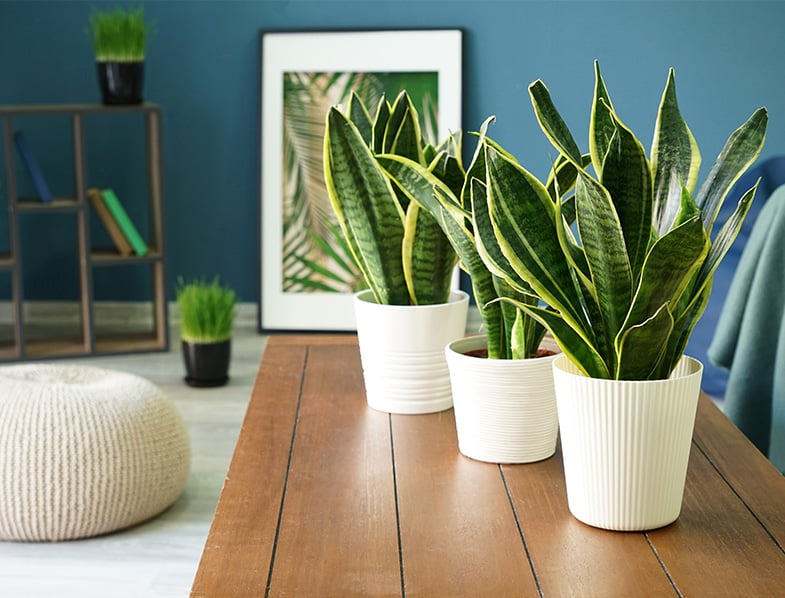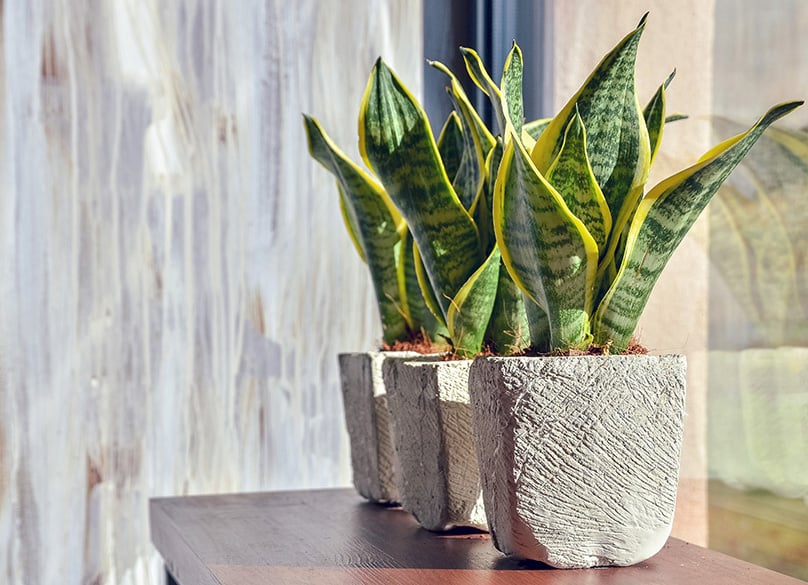If you’re looking for attractive plants for indoors or your yard, then consider snake plants.
Also known as “Sansevieria,” snake plants are among the easiest house plants to care for, making them the ideal choice for beginner gardeners.
Snakes plants are native to the southern regions of Africa, where they grow abundantly. African tribes would harvest the plants for their durable fibers, using them in the construction of equipment like bow-strings. However, the United States classifies snake plants as an invasive species, so we recommend you to keep these plants indoors.
Filling your home with snake plants enhances the air quality. These plants absorb toxins like formaldehyde from the air, making them the ideal housewarming gift. Here’s everything you need to know about planting and maintaining your snake plants.

Here is our recommended online shops for purchasing succulents & supplies
 Succulents Box
Succulents BoxSucculents Box currently offers more than 200 varieties of succulents (both popular and rare ones) along with 5 monthly subscription boxes.
Visit Store Leaf & Clay
Leaf & ClayLeaf & Clay offer a range of hundreds of types of succulents along with subscription boxes, pots & macrame.
Visit Store Lula’s Garden
Lula’s GardenLula’s Garden offers a selection of succulent garden gift sets from small single succulents in pots to full succulent gardens.
Visit Store The Succulent Source
The Succulent SourceThe Succulent Source offers a huge selection of succulents, cactii and also gift sets and items for weddings.
Visit Store Planet Desert
Planet DesertPlanet Desert cater to succulent and cactii fans with a large range of plants, soil, kits and other supplies for creating your garden.
Visit Store

Snake Plant Characteristics
Snake plants have long, blade-shaped leaves, with variegated shades of green, and they stand up straight in the air. The leaves of the plant look like giant blades of grass, and they may reach as tall as 4-feet in height.
Gardeners refer to the roots of snake plants as “rhizomes,” which means that the root system can experience growth anywhere at any time. As a result, it’s easy to propagate snake plants, splitting them into multiple clumps you can transplant to other pots.
Planting snake plants outdoors results in the plants spreading quickly, and they’ll take over the local area in a season or two. It’s for this reason that we recommend you grow your snake plants in pots indoors.
The root systems of snake plants are shallow, and you don’t need a huge pot to grow the plants. However, we recommend you choose a container with a decent weight. If the snake plant grows too large, the height and weight of the leaves may cause the pot to fall over.

Where to Buy a Snake Plant?
Check with local nurseries for snake plants. Not all nurseries will stock them, due to the plant being an invasive species. However, if you look around, it won’t take you long to find a garden center or nursery offering the plants for sale. Snake plants are relatively expensive, and you can expect to pay anywhere from $40 to $100, depending on the size and health of the plant.
Snake plants are exceptionally hardy and put up with the most hostile growing conditions. It’s also easy to propagate these plants every year, producing more pants to expand your indoor garden. However, places like Amazon also offer snake plants for half that price.

Live Indoor Snake Plant, From Amazon
Planting Your Snake Plants
When selecting the container for your snake plants, we already made our recommendations on choosing a pot that has a decent weight to prevent it from falling over. However, snake plants have short roots that like to lay close to the surface of the soil. As a result, you can get away with less watering, and you don’t need a deep pot.
Add some potting soil, and add some perlite in a 2:1 ratio to improve the drainage of the soil. We recommend you look into purchasing soils meant for succulent plants like cactus. When planting, make sure you bury the roots at the same depth as the mother plant and don’t plant too deep, or you’ll run the risk of the roots rotting.
Keep your snake plant in a room in the home that gets indirect sunlight. Snake plants will wither and burn in direct sunlight. Keep the plants away from windows and drafts during the wintertime, as these plants don’t enjoy it when temperatures drop below 50°F.
Caring for Your Snake Plants
Snake plants are almost as resistant to drought conditions as cactus. As a result, these plants don’t require much in the way of maintenance and care. They’re the ideal choice for newbie indoor gardeners that had plants die on them previously due to lack of adequate care.
Watering is a severe issue with snake plants, and you’ll need to ensure that the soil drains well to prevent the onset of root rot in the plant. Wet roots lead to the emergence of disease that can kill your plant, and spread to other pot plants in your home.
We recommend that you use the finger test for checking when it’s time to water your snake plants. Press your finger 2-inches into the soil, and check for moisture. If the soil has moisture, then avoid watering for a few days to let the roots dry out.
We also recommend that you water your plants with room-temperature water. If you water with cold water, it results in the scarring of the plant’s leaves. If the leaves of the plant start to collect dust, then wipe them down using a damp cloth.
Creating an indoor garden with companion plants like cactus, succulents and spider plants is a great way to create an indoor garden that uses very little water over the growing season. Snake plants don’t require any fertilizer, and they grow readily in only the nutrients they find in the soil mix.
We recommend that you re-pot your snake plants every three to five years. Snake plants have no problem with being root-bound. However, the roots are strong, and large plants can even end up cracking clay pots.
Considerations for Potting Snake Plants
If you decide to pot your snake plants indoors, then you’ll benefit from the plant’s ability to clean toxins from the air. However, to have your snake plant grow to optimal levels of health, you’ll need to ensure that you have the right container and the right soil mix.
Growing snake plants in large containers result in large plants. Similarly, growing in small containers produces small plants. The container plays a significant role in determining the final size and height of the plant, so make sure you take careful consideration when purchasing the right container for your home.
It’s also important to note that snake plants like a clumped up root system, and the plant has no issues with becoming root-bound in the pot. If the plant continues to grow, it may split the sidewalls of plastic containers.

If your snake plant is getting too big for its pot, then consider propagating the plant into two or three other plants, and spread them around your home.
Snake plants have solid roots, and without the right drainage, the plant develops root rot. Therefore, you’ll need to ensure that your container has adequate holes for draining. Add a layer of gravel to the bottom of the pot to enhance drainage and use perlite in the soil.
If you accidentally purchase a planter with no holes, then you can use an electric drill to punch more holes in the bottom of the container. We recommend that you use a water tray to avoid the water spilling onto your floor.
However, snake plants don’t require much water, and you should let the soil dry out between waterings as well. These plants come from regions of the world where droughts are frequent, and if they stay dry for a while, it won’t cause any issues with your snake plants.
Pests and Diseases Affecting Snake Plants
Since you’re going to be growing snake plants indoors, then you shouldn’t have to concern yourself with pests and diseases affecting the health of your plants. However, you’ll need to pay careful attention to your watering protocol. Over-watering your plants can result in the plant getting its “feet wet,” resulting in the onset of root rot in the plant.
When root rot starts in your snake plants, you’ll notice that the tips of the leaves begin to turn yellow. You might also see that the leaves of the plant feel somewhat squishy between your fingers.
If you do get root rot starting in your plants, then dry them out immediately. There’s a chance that you can salvage the plant, due to its hardy nature. Your plant should take two to three weeks to recover, and don’t give it any water during this time, as it will increase the rot.
Those gardeners planting outdoors might also have to deal with spider-mite and mealybug infestations. Spider-mites weave a web around the leaves of the plants, and they’re easy to identify. Mealybugs that start eating your plants cause the foliage to wilt and die. Use organic pesticides to get rid of these critters.
Recommended Snake Plant Varieties
There are nearly 80 variations of snake plants, and most of them are native to the southern region of Africa, as well as Madagascar and south Asia.
Snake plants played a significant role in these cultures as a provider of fiber for a variety of purposes, from weaving ropes and baskets to manufacturing bow-strings.
Here are the top three varieties of snake plants we recommend for your indoor garden.
- “Sansevieria trifasciata” – This species is the most common snake plant. It features dark-green foliage with light green-gray horizontal stripes.
- “Golden Hahnii”– The leaves of this snake plant feature yellow variegation on the edge of the leaves.
- “Bantel’s Sensation” – These snake plants have narrow leaves with vertical white stripes and grow to lengths of 3-feet.

1 Comment
I have several snake plants that are doing somewhat ok , but I really need to know how often should I water them. I try to water them once a month, (I make sure that the soil is really dry) I have lost some leaves on some.
I have now invested in a cool mist humidifier. I have the following plants in my home (pothos, ZZ’s, snakes, aloes & spider. I live in Colorado. Thanks